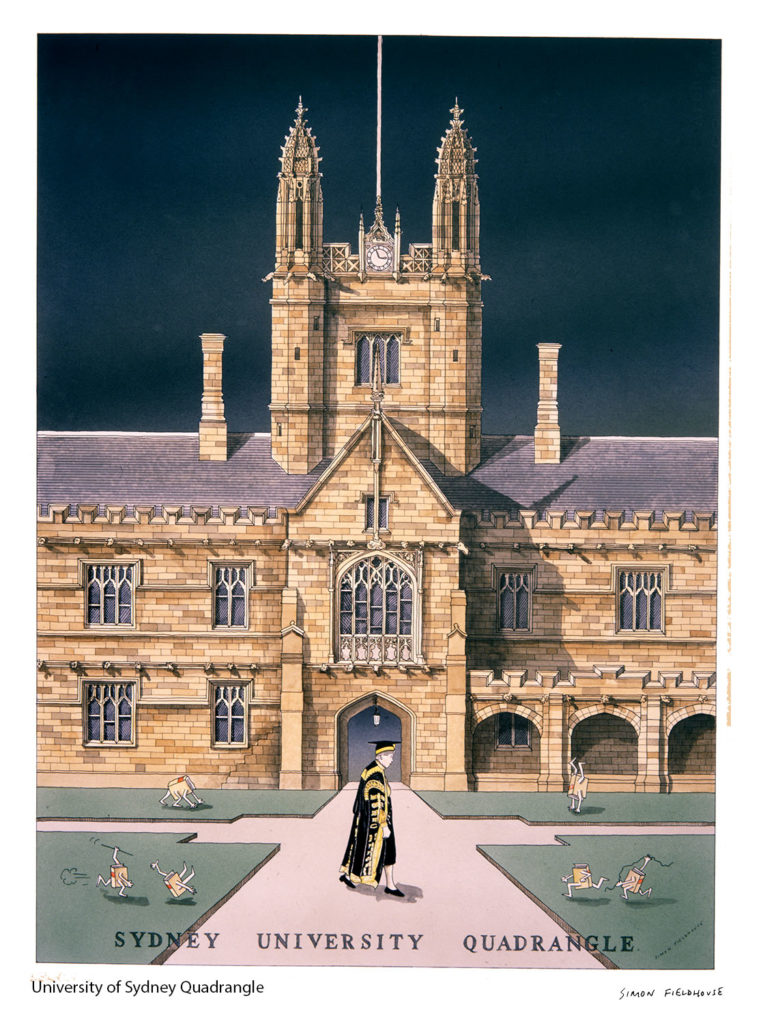
University of Sydney Quadrangle - Dame Leonie Kramer
University of Sydney Quadrangle is a prominent sandstone building located within the University of Sydney Camperdown Campus. Taking over 100 years to complete, the Quadrangle was designed and developed by numerous contributors including Edmund Blacket, James Barnet, and Leslie Wilkinson.The original building included the Great Hall and was constructed between 1855 and 1862. Construction on the quadrangle began in 1854, it had four sides by 1926,and was completed in the 1960s after several stages of development. It comprises the Great Hall, MacLaurin Hall, Faculty of Arts office and the Nicholson Museum. MacLaurin Hall was constructed from 1902-1904 and was designed by Walter Liberty Vernon. The architectural style of the Quadrangle is gothic revival. The building is mostly constructed of sandstone and is unique in the Australian architectural landscape. At the time of its completion, the Quadrangle was ‘the largest public building in the colony.’ The Traditional Indigenous owners of the land on which the Quadrangle was built belonged to the Cadigal and Wangal tribes of the Eora people.The main entrance - constructed first along with the Great Hall - is underneath the clock tower, which hold one of only two carillons in Australia.
Robert Strachan Wallace, the university's vice chancellor from 1928 to 1947, upon taking up his position found the quadrangle to be "overgrown, and the grounds beyond...in much worse repair". He embarked on a restoration program, for which he became known as the "building vice chancellor".
The Quadrangle design is based on those of Oxford and Cambridge. It contains one of only two carillons in Australia, the other being the one on Aspen Island in Canberra.
The Quadrangle is categorised under Sandstone Universities which are informally known as Australia's oldest universities. Commonly known as the first building for Australia's first university, the Quadrangle itself is built in an anachronistic style, which was already outdated by the time it was built. Edmund Blacket , one of the architects responsible for the design of the Quadrangle, was also known for other works in Sydney such as St. Andrew's Cathedral. Blacket primarily focused on Victorian Gothic Revival architecture, which influenced James Barnet's design of Sydney University's Andersen Stuart Building. In 1924, the Quadrangle comprised four walls, in which are included bronze pipes which state the year they were placed. The final completion of the Quadrangle's exterior display was during the 1960s, which included work on the West Tower.
Dame Leonie Kramer, a name that resonates with the cultural and intellectual history of Australia, is a prominent figure whose life and contributions have left an indelible mark on the nation. Born on August 1, 1924, Dame Leonie Kramer emerged as a distinguished academic, author, and cultural ambassador, shaping Australia's intellectual landscape and contributing significantly to its cultural heritage.
Kramer's academic journey began at the University of Sydney, where she excelled in her studies and developed a lifelong passion for literature and education. She earned her doctorate from the University of Oxford, becoming one of the first Australian women to do so. Her academic achievements paved the way for a remarkable career in academia, where she dedicated herself to the study of English literature and education.
One of Kramer's most notable roles was her tenure as Vice-Chancellor of the University of Sydney from 1991 to 1995. During her leadership, she implemented several reforms that modernized and diversified the university, making it more inclusive and internationally renowned. Her commitment to educational excellence earned her widespread recognition and respect.
Beyond her academic pursuits, Dame Leonie Kramer was an accomplished author and literary critic. Her publications, including books and essays, explored Australian literature, culture, and identity. Through her writings, she contributed to the preservation and celebration of Australian literary heritage.
Dame Leonie Kramer's cultural significance extends beyond her academic and literary achievements. She was a patron of the arts, promoting cultural endeavors across the nation. Her support for Australian artists and writers helped nurture and showcase local talent on the global stage.
In recognition of her outstanding contributions, Kramer was appointed Dame Commander of the Order of the British Empire (DBE) in 1983 and became a Companion of the Order of Australia (AC) in 1991. These honors reflected her dedication to education, culture, and the betterment of Australian society.
In conclusion, Dame Leonie Kramer's life and work represent an enduring legacy of intellectual achievement and cultural significance in Australia. Her contributions as an educator, author, and cultural ambassador have enriched the nation's cultural tapestry and inspired generations to pursue excellence in education and the arts. Dame Leonie Kramer remains an iconic figure in Australian history, celebrated for her profound impact on the nation's cultural and intellectual landscape.